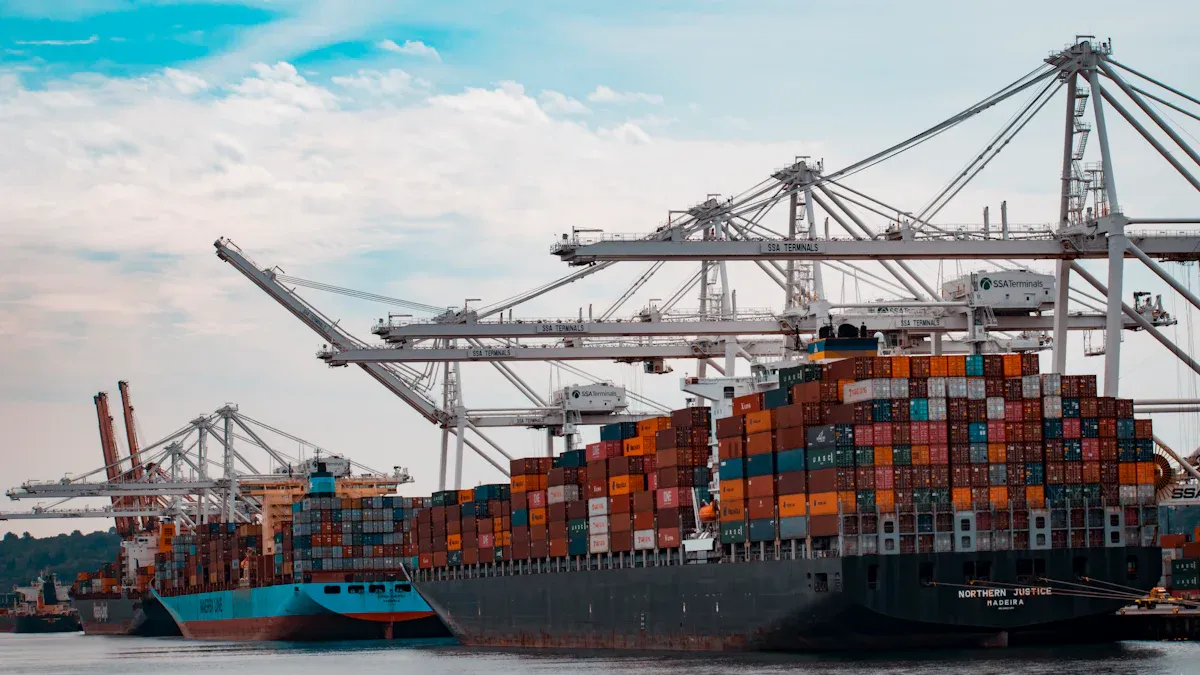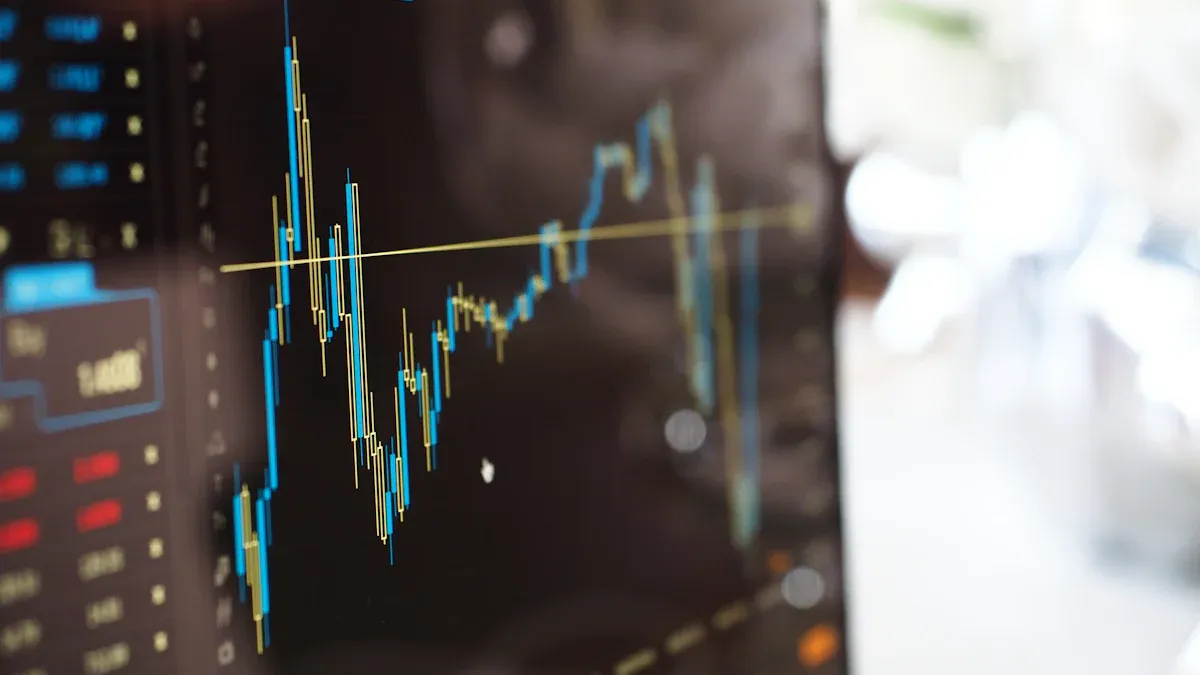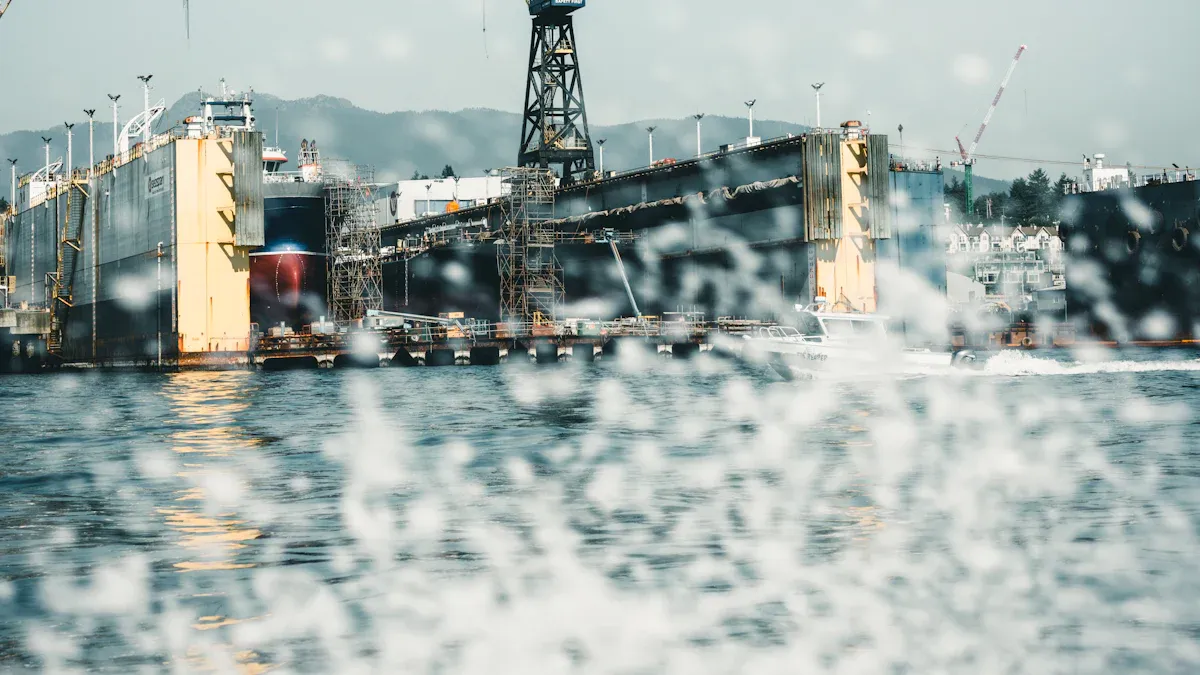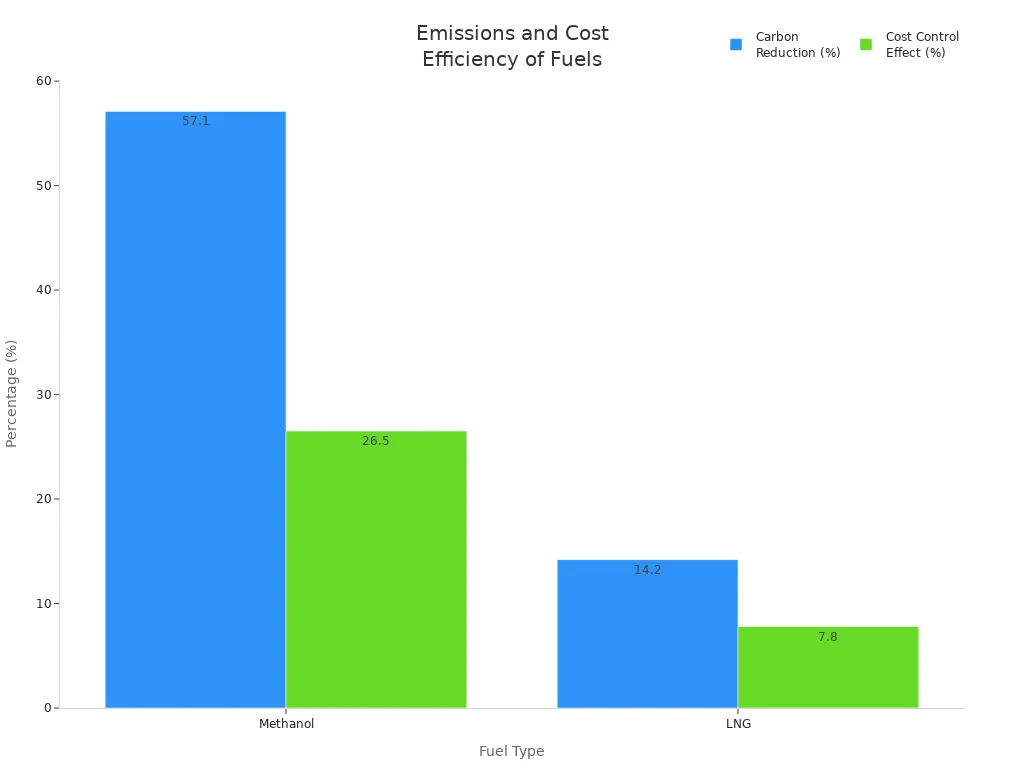Top Trends Shaping International Container Shipping in 2025

You will see major changes in the shipping industry in 2025. Technology, sustainability, and new regulations drive international container shipping forward. Top shipping companies face rising costs and new risks.
The shipping industry expects higher freight rates, increased port dues, and strong demand for lithium-ion battery transport.
Trend Description | Impact on Costs |
|---|---|
Increasing market concentration among international forwarders | High freight rate targets set by forwarders, potentially leading to increased costs. |
Use of alternative routes to avoid geopolitical risks | Additional fixed costs of around $1,000 per container on Asia-Europe routes. |
Decarbonization efforts in shipping | Significant investments required for green technologies, raising costs. |
You must adapt quickly as international shipping evolves. You need new skills and flexibility to succeed at a shipping company.
Key Takeaways
Embrace digitalization to enhance efficiency. Use real-time data and automation to streamline shipping processes and improve customer satisfaction.
Focus on sustainability by adopting green technologies. Invest in eco-friendly vessels and alternative fuels to reduce your environmental impact.
Diversify your supply chain to build resilience. Use multiple shipping routes and suppliers to manage risks and ensure steady operations.
Digitalization in International Container Shipping

Digitalization is changing the shipping industry at a rapid pace. You now see smarter systems, faster responses, and greater transparency in every shipping process. As a freight forwarder or logistics professional, you benefit from new technologies that make your work easier and more reliable.
Automation
Automation leads the way in transforming the shipping process. Smart containers use IoT to share real-time data about location and cargo conditions. Automated cranes and robots speed up port operations, reducing human error and increasing safety. In major ports, automation has cut operational costs by up to 55% and lowered carbon emissions. You can manage more shipments with fewer resources, making the shipping process more efficient. JUSDA’s JusLink AI Solution uses automation to streamline tasks like demand forecasting and inventory management, helping you avoid delays and reduce costs.
Real-Time Data
Real-time data gives you full visibility into every shipment. You can track containers, monitor inventory, and respond quickly to disruptions. This level of transparency improves customer satisfaction and helps you make better decisions. Studies show that companies using real-time data see a 20% reduction in lead times. JusLink’s AI Solution provides instant updates and predictive analytics, so you always know where your shipment is and what actions to take next. This technology makes the shipping process smoother and more reliable.
Blockchain
Blockchain technology brings a new level of trust to the shipping industry. It secures documents, tracks shipments, and prevents fraud. With blockchain, you can access tamper-proof records and share information with partners safely. Leading companies use blockchain to cut transit times and improve transparency. JUSDA integrates blockchain into its smart logistics platform, giving you confidence in every shipping process and helping you meet compliance standards.
Sustainability Trends

The shipping industry faces growing pressure to adopt eco-friendly practices. You see new regulations and customer expectations driving change in every export process. Companies now invest in green technologies and sustainable solutions to reduce their environmental impact.
Green Shipping
You play a key role in making the export process greener. Environmental responsibility is now essential for every shipping company. Many businesses invest in energy-efficient vessels and sustainable packaging. Containers use recyclable materials and greener manufacturing methods.
The following trends shape the future of green shipping:
Eco-friendly port infrastructure and shore power integration
Fuel innovations like biofuels and LNG
Hydrogen and ammonia as future fuels
Emission reduction strategies and carbon offsetting
Reducing empty container movements for efficient shipment
A look at the numbers shows why these changes matter:
Statistic | Description |
|---|---|
Freight shipments account for this share of global emissions. | |
91% of US packaging waste | Ends up in landfills or the environment. |
Over a third | Logistics and transport sector’s share of global CO2 emissions. |
JUSDA leads the way by focusing on innovation and efficiency in sustainable logistics. You benefit from solutions that support a cleaner export process and responsible shipment management.
Alternative Fuels
You see alternative fuels becoming a top priority in the export process. Methanol and LNG are popular choices for reducing emissions in shipping. Methanol stands out for its lower carbon footprint and cost efficiency compared to LNG.

Methanol offers a 57.1% reduction in carbon emissions and the lowest total cost for shipment. LNG provides some benefits but comes with higher costs. You need the right infrastructure, such as zero-emission fuel tanks, to support these new fuels in the export process.
Compliance
You must stay updated on compliance requirements in the shipping industry. The Corporate Sustainability Reporting Directive (CSRD) now applies to many companies involved in the export process. Large organizations and non-EU companies with significant EU business must report on sustainability.
The EU Emissions Trading System (EU ETS) also covers shipping. From 2025, offshore vessels over 5,000 GT calling at EU ports must comply. You need to track emissions data and submit reports on time to avoid penalties.
JUSDA helps you navigate these rules, making your export process smoother and more sustainable.
Supply Chain Resilience
You face new challenges every day in global trade. Building a resilient supply chain helps you manage risks and keep your shipments moving, even when disruptions occur. The shipping industry now relies on smart strategies and advanced tools to protect your business and support global expansion. JUSDA’s solutions and customer stories show how you can overcome the challenges faced during international container shipping.
Route Diversification
You can reduce risk by diversifying your shipping routes and suppliers. Segmenting and regionalizing your supply chain limits the impact of natural disasters or geopolitical issues. For example, a study of 1,434 Chinese manufacturing firms during the COVID-19 crisis found that companies with diversified supply bases had more supply streams and higher profits during disruptions. Large brands like Zara use multiple suppliers to lower costs and keep shipments steady if one source faces problems. This approach keeps your global trade operations stable and flexible.
Risk Management
You need strong risk management tools to handle uncertainty in the shipping process. Many companies use ERM platforms to link business goals with specific risks. GRC solutions help you manage risks, policies, and compliance, giving everyone access to the same information. Specialized risk tools focus on areas like cyber risk, third-party risk, and environmental compliance. JUSDA’s JusLink AI Solution offers real-time risk monitoring and predictive analytics, helping you avoid costly delays and protect your shipments.
Collaboration
Collaboration with logistics partners strengthens your supply chain. When you share risk management strategies, you can spot disruptions faster. Pooling resources and expertise lets you create strong contingency plans. Open communication and joint planning help you adapt quickly to changes in global trade. JUSDA’s customer stories highlight how teamwork supports manufacturers as they expand worldwide, making the shipping process smoother for every freight forwarder.
Table: Key Strategies for Supply Chain Resilience
Strategy | Description |
|---|---|
Hub-and-Spoke Network Model | Increases flexibility and reliability with adaptive scheduling for global trade. |
Demand Forecasting and Risk Analysis | Uses AI to predict demand and adjust capacity for efficient shipping. |
Port and Terminal Resilience | Maintains skilled staff and reliable systems to manage shipment disruptions. |
Government Support | Reopens old terminals to reduce congestion and keep shipments moving. |
Visibility and Data Integration | Enables real-time monitoring for quick responses in the shipping process. |
Third-Party Risk Management | Assesses and reduces risks across suppliers and logistics providers. |
Regulatory Shifts
You must stay alert to regulatory shifts in the shipping industry. These changes shape global trade and affect every freight forwarder and shipment. Geopolitical disruptions, emission mandates, and shifting alliances now drive new rules in international shipping. You see these changes in daily operations and long-term planning.
IMO 2025
The International Maritime Organization (IMO) sets new standards for the shipping process. You need to comply with stricter emission rules and cybersecurity protocols. Companies prepare to meet the IMO’s goal of cutting greenhouse gas emissions by 40% by 2030. You see ship operators switching to cleaner fuels and investing in greener technologies. Cybersecurity measures also become essential for protecting your shipment data.
Adaptation Strategy | Description |
|---|---|
Compliance with emissions standards | Companies are preparing to meet the IMO's goal of reducing greenhouse gas emissions by 40% by 2030. |
Adoption of cleaner fuels | Ship operators are shifting towards low-emission fuels and greener technologies to comply with new rules. |
Enhancement of cybersecurity measures | The IMO requires improved cybersecurity protocols to protect against increasing cyber threats in maritime operations. |
JUSDA helps you navigate these changes with smart solutions and expert guidance.
Trade Policies
Trade policies now impact global trade routes and shipping costs. You must monitor tariffs, trade agreements, and regulatory compliance. Changes in trade volumes affect freight rates and container usage. New safety and emissions regulations increase operational costs. Tariffs and trade barriers can raise shipping expenses and force you to evaluate alternative routes. Supply chain disruptions from trade tensions may cause delays and port congestion. You see companies investing in port infrastructure and logistics networks to adapt.
Trade Volumes: Tariffs and agreements change shipping demand and freight rates.
Regulatory Compliance: Safety and emissions rules require adjustments and raise costs.
Cost Implications: Tariffs, trade barriers, and fuel price changes affect shipping expenses.
JUSDA’s expertise supports you in adapting to these shifts and finding cost-effective solutions.
Customs
Customs clearance remains a critical part of the shipping process. You must prepare the right documents and follow country-specific rules. Each shipment needs a commercial invoice, packing list, bill of lading, and destination forms. Customs authorities enforce restrictions on certain items and protect intellectual property rights. Environmental and health regulations also apply in many markets.
Document Type | Description |
|---|---|
Commercial Invoice | Provides a detailed transaction record. |
Packing List | Enumerates all items in the shipment. |
Bill of Lading | Serves as a receipt and contract between the shipper and carrier. |
Country-Specific Forms | Various additional documents required by the destination country. |
You can work with experienced logistics partners like JUSDA, use technology, and maintain good records to ensure smooth customs clearance. JUSDA’s global trade expertise helps you avoid delays and keep your shipments moving.
Fleet Modernization
Fleet modernization shapes the future of global trade. You see new vessels, advanced retrofitting, and market volatility changing how you manage shipping and shipments. As a freight forwarder, you must understand these trends to stay competitive in the shipping industry.
New Vessels
You notice companies investing in larger and more fuel-efficient ships. These new vessels improve operational efficiency and support sustainable global trade. Some of the most advanced ships include:
Yara Birkeland: The first fully electric autonomous container vessel.
ASKO's electric, self-driving container vessels: Designed for emission-free transport across the Oslofjord.
MSC Irina: The largest container ship in the world, carrying over 24,346 TEUs.
These ships use IoT, telematics, and automation to enhance performance and customer experience. Strategic partnerships also help address capacity gaps and improve network efficiency.
Trend | Description |
|---|---|
Investments in Ships | Companies invest in larger, fuel-efficient ships for better operational efficiency. |
Technology Adoption | IoT and automation improve fleet performance and customer experience. |
Strategic Partnerships | Collaborations address capacity gaps and boost network efficiency. |
Retrofitting
You see retrofitting as a key way to modernize existing fleets. Companies upgrade ships with alternative fuel systems, wind-assisted propulsion, and advanced propellers. These changes reduce emissions and improve efficiency.
Technology | Impact on Emissions | Impact on Efficiency |
|---|---|---|
Alternative Fuel Systems | Improved performance | |
Wind-assisted Propulsion | Reduces fuel usage | Enhances speed |
Hull Improvements | Lowers drag | Increases fuel efficiency |
Advanced Propellers | Reduces emissions | Boosts operational performance |
Carbon Capture Solutions | Captures CO2 | Supports decarbonisation |
For example, Hapag-Lloyd retrofitted the Sajir container ship to run on LNG, cutting emissions. The company plans to make ships methanol-ready by 2026 to meet customer demand for greener global trade.
Market Volatility
You face market volatility from several sources. Geopolitical tensions, such as those between Israel and Iran, disrupt energy supply routes. Houthi activity in the Red Sea threatens shipping through the Suez Canal. Oil sanctions and evolving U.S. import tariffs complicate international trade. Uncertainties around Chinese GDP growth affect global economic recovery.
Raw material price swings, especially in steel, impact the cost of shipping containers. These changes make it hard for manufacturers and freight forwarders to plan long-term investments. Volatility in global demand and raw material prices can reduce demand for new containers and affect shipment strategies.
Tip: Stay informed about global trade trends and work closely with logistics partners to manage risks in your shipping operations.
China-Europe Express Rail by JUSDA
Rail Solutions
You can transform your shipping strategy with JUSDA’s China-Europe Express Rail. This service sets a new standard for international container shipping. Trains depart every two days, so you avoid delays common with sea shipping. You get your goods delivered in just 15-20 days, which is much faster than the 30-40 days typical for sea freight. The cost remains competitive, ranging from $5,000 to $7,000 per container. You also benefit from reliable schedules, since rail shipping is less affected by weather disruptions.
“Many companies are happier with Rail Freight. It’s faster, less hassle and less can cause a delay, especially during the shortages and challenges we’re dealing with in late 2021.”
Feature/Benefit | Description |
|---|---|
Dedicated & High-Frequency | Trains depart every two days, ensuring timely arrival and avoiding delays. |
Optimized Cost & Risk | Reduces transport costs by over 20% and lowers supply chain disruption risk. |
Intermodal Options
You can boost your shipping efficiency by using JUSDA’s seamless multimodal integration. The China-Europe Express Rail connects road and rail networks, making logistics smoother for you. This integration helps you move goods across borders with fewer interruptions. You can combine rail with road transport to reach more destinations and keep your shipping process flexible. JUSDA’s collaboration with partners ensures that your shipments stay on track and arrive on time.
Aspect | China-Europe Express Rail | Traditional Shipping (Sea Freight) |
|---|---|---|
Speed | 15-20 days | 30-40 days |
Cost | $5,000 - $7,000/container | Lower, but varies |
Reliability | Fewer weather delays | More affected by weather |
Industry Applications
You can use the China-Europe Express Rail for many industries, including electronics, clothing, and medical supplies. Manufacturers rely on this shipping solution to meet tight deadlines and reduce costs. Fast-moving consumer goods companies benefit from quick delivery and stable supply chains. Medical suppliers use rail shipping to ensure timely arrival of sensitive products. JUSDA’s rail service helps you avoid supply chain disruptions and supports your global expansion.
Electronics: Fast delivery for high-value goods.
Clothing: Reliable schedules for seasonal shipments.
Medical: Secure transport for sensitive supplies.
You gain a competitive edge by choosing a shipping solution that balances speed, cost, and reliability.
Leading Container Shipping Companies
Industry Leaders
You see several container shipping companies leading the global market in 2025. These companies set the standards for reliability, scale, and innovation in the shipping industry. Here are the top five container shipping companies you should know:
Mediterranean Shipping Company (MSC)
Maersk Line
China Ocean Shipping Company (COSCO)
Evergreen Marine Corporation (EMC)
Ocean Network Express (ONE)
Each of these container shipping companies operates massive fleets and serves major trade routes. You benefit from their global networks and advanced logistics solutions. These leaders invest in new vessels and digital tools to keep your shipping efficient and secure.
Service Innovations
You notice that container shipping companies now focus on service innovations to meet your changing needs. Many companies use real-time tracking, automated booking systems, and AI-powered route optimization. These features help you manage your shipping with greater accuracy and speed. Some container shipping companies offer eco-friendly options, such as low-emission vessels and green logistics services. You can also find flexible intermodal solutions that combine sea, rail, and road transport for seamless delivery.
Tip: Choose container shipping companies that invest in technology and sustainability. You gain better visibility, lower costs, and more reliable shipping.
You shape your supply chain by selecting the right partners. The top container shipping companies continue to drive progress in the shipping industry, making global trade smoother for you.

JUSDA Solutions
To provide you with professional solutions and quotations.
You see international container shipping changing fast in 2025.
Digital tools, green solutions, and new rules shape your daily shipping work.
You must focus on innovation, resilience, and sustainability to succeed in international container shipping.
Stay alert to trends in international container shipping and shipping technology. You can lead in international container shipping by learning and adapting.
See Also
Exploring Innovations in Sea Freight Logistics for 2024
Five Key Trends Shaping Future Supply Chain Efficiency
Get Prepared: New Transport Technology Trends for Supply Chains
Understanding Current Trends in Logistics Risk Management
Explore Five Essential Events for Supply Chain Professionals
